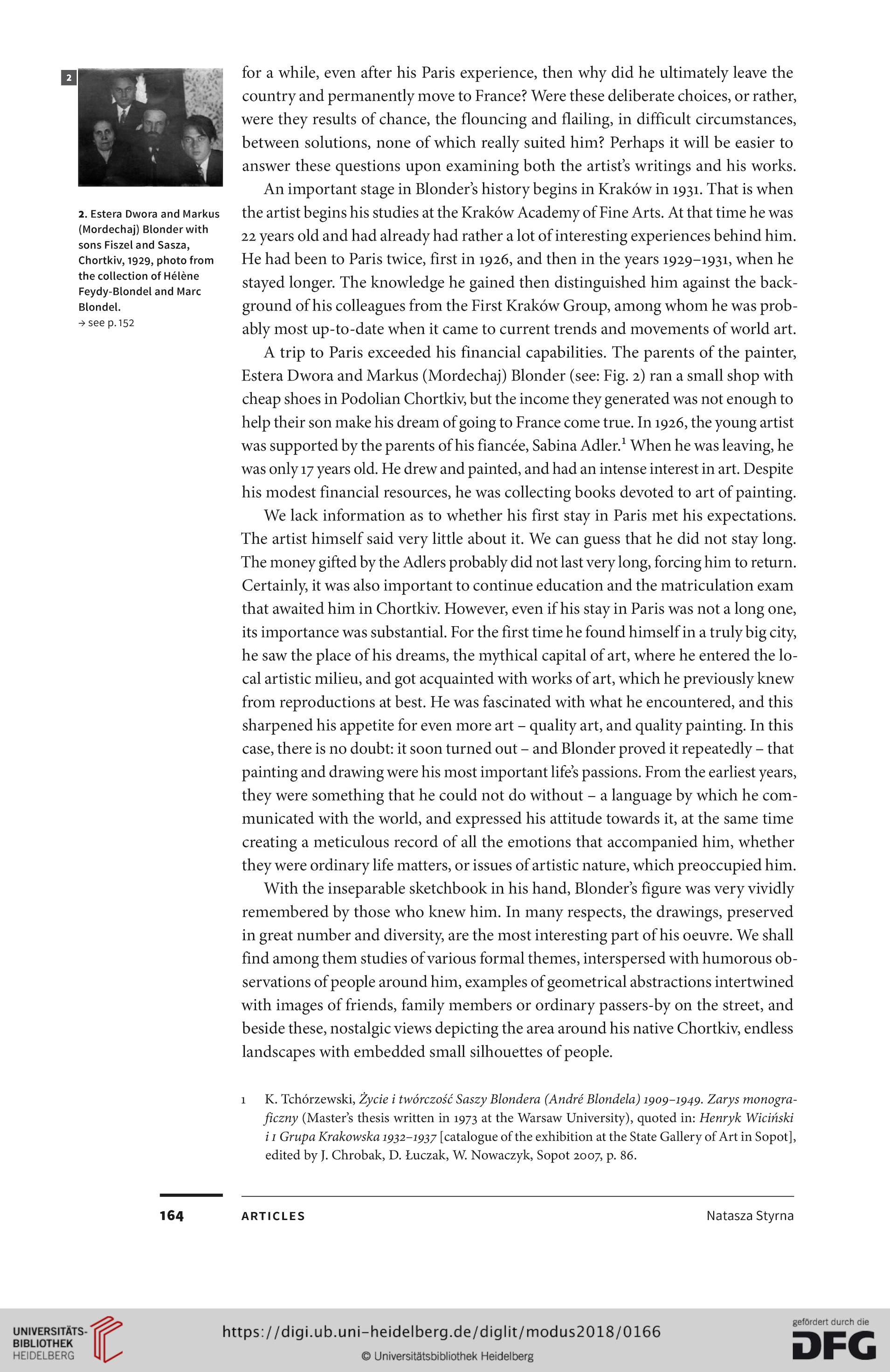2. Estera Dwora and Markus
(Mordechaj) Blonderwith
sons Fiszel and Sasza,
Chortkiv, 1929, photo from
the collection of Helene
Feydy-Blondel and Marc
Blondel.
-> see p.152
for a while, even after his Paris experience, then why did he ultimately leave the
country and permanently move to France? Were these deliberate choices, or rather,
were they results of chance, the flouncing and flailing, in difficult circumstances,
between Solutions, nonę of which really suited him? Perhaps it will be easier to
answer these questions upon examining both the artists writings and his works.
An important stage in Blonder s history begins in Kraków in 1931. That is when
the artist begins his studies at the Kraków Academy of Fine Arts. At that time he was
22 years old and had already had rather a lot of interesting experiences behind him.
He had been to Paris twice, First in 1926, and then in the years 1929-1931, when he
stayed longer. The knowledge he gained then distinguished him against the back-
ground of his colleagues from the First Kraków Group, among whom he was prob-
ably most up-to-date when it came to current trends and movements of world art.
A trip to Paris exceeded his financial capabilities. The parents of the painter,
Estera Dwora and Markus (Mordechaj) Blonder (see: Fig. 2) ran a smali shop with
cheap shoes in Podolian Chortkiv, but the income they generated was not enough to
help their son make his dream of going to France come true. In 1926, the young artist
was supported by the parents of his fiancee, Sabina Adler.1 When he was leaving, he
was only 17 years old. He drew and painted, and had an intense interest in art. Despite
his modest financial resources, he was collecting books devoted to art of painting.
We lack information as to whether his first stay in Paris met his expectations.
The artist himself said very little about it. We can guess that he did not stay long.
The money gifted by the Adlers probably did not last very long, forcing him to return.
Certainly, it was also important to continue education and the matriculation exam
that awaited him in Chortkiv. However, even if his stay in Paris was not a long one,
its importance was substantial. For the First time he found himself in a truły big city,
he saw the place of his dreams, the mythical Capital of art, where he entered the lo-
cal artistic milieu, and got acquainted with works of art, which he previously knew
from reproductions at best. He was fascinated with what he encountered, and this
sharpened his appetite for even morę art - quality art, and quality painting. In this
case, there is no doubt: it soon turned out - and Blonder proved it repeatedly - that
painting and drawing were his most important lifes passions. From the earliest years,
they were something that he could not do without - a language by which he com-
municated with the world, and expressed his attitude towards it, at the same time
creating a meticulous record of all the emotions that accompanied him, whether
they were ordinary life matters, or issues of artistic naturę, which preoccupied him.
With the inseparable sketchbook in his hand, Blonder s Figurę was very vividly
remembered by those who knew him. In many respects, the drawings, preserved
in great number and diversity, are the most interesting part of his oeuvre. We shall
Find among them studies of various formal themes, interspersed with humorous ob-
servations of people around him, examples of geometrical abstractions intertwined
with images of friends, family members or ordinary passers-by on the Street, and
beside these, nostalgie views depicting the area around his native Chortkiv, endless
landscapes with embedded smali silhouettes of people.
1 K. Tchorzewski, Życie i twórczość Saszy Blondera (Andre Blondela) 1909-1949. Zarys monogra-
ficzny (Master s thesis written in 1973 at the Warsaw University), quoted in: Henryk Wiciński
i 1 Grupa Krakowska 1932-1937 [catalogue of the exhibition at the State Gallery of Art in Sopot],
edited by J. Chrobak, D. Łuczak, W. Nowaczyk, Sopot 2007, p. 86.
164
ARTICLES
Natasza Styrna




